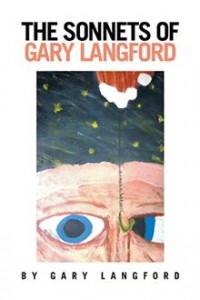Title: The Sonnets of Gary Langford
Author: Gary Langford
Publisher: XlibrisAU
ISBN: 978 -1-5144-9542-1
Pages: 186
Genre: Poetry
Reviewed by: J.W. Bankston
Buy on AmazonPacific Book Review
Gary Langford did more than celebrate “lasting exactly 30 years in the educational system” with a glass of champagne or a vacation. He began seriously painting and writing poetry. “The Sonnets of Gary Langford,” is the result of one of those endeavors. The collection is incredibly varied, with elements of tragedy and pathos accompanied by bracing humor, both light and black. The poems dramatically illustrate the thoughts and experiences of a life well-lived. Then again, nothing less could be expected from a writer for stage and screen who is also the author of nearly three dozen books, including 14 novels.
In a 2013 interview with Nicholas R. W. Henning, Langford admitted that it took time for his voice as a writer to develop. Its arrival meant, he explained, “you know what you can do, irrespective of the market, and you are comfortable with it. This came when I no longer wrote for money…” In “The Sonnets of Gary Langford,” he generally follows the advice he offers to aspiring writers in the Henning interview, “Do NOT write on abstract distant pieces to your experience, write on what you know and understand.”
Because the book is divided into two parts, readers can choose to explore the darker verse of “Serious Sonnets” (SS) or the happier tone found in “Lighter Sonnets Down Under” (LSD). Both sections demonstrate Langford’s tight grasp of language. In “On the Bus” an observer describes, “Out on the balcony the future plays,” while “At The Shelter” describe how, “Problems are coughed up in the night’s moan.” Of course Langford’s power reflects decades as a writer and a teacher of writing. He is also someone who casually drops the word “pedant” into a book’s introduction (the more obscure definition of which is “male teacher.”)
The first poems are almost naturalistic. Readers of John Steinbeck, Jack London and James Dickey will recognize this prose style characterized by both social Darwinism and human inability to exercise free will when matched against nature’s far more powerful force. The irony here is that Langford’s most naturalistic poems don’t feature people at all. Instead, we are offered the sad life arc of a pig in seven poems concluding with “Pig Art:” “Pigs are triumphantly sketched and bought.”
I’ll admit that I preferred the occasional silliness of Part Two to sonnets about Hitler and slaughtered swines. Here Langford offers amusing eroticism with “Daughter:” “Tongues have a new significance” and laugh out loud alliteration in “The Bangabout” with the opening lines of “Boggly birds sit on branches of the bangabout – barping bippets of bidely bours….”. Like the best books of poetry, Langford’s collection provides both insight and escapism. Readers who enjoy poets both popular and obscure will find more than just pleasant diversion in “The Sonnets of Gary Langford.” They will come to appreciate, as I have, that Langford celebrated three decades in the educational system with more than a mere glass of bubbly.


